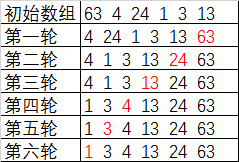在Java中,实现数组的排序算法有很多,如冒泡排序法、选择排序法、直接插入法和快速排序法等。下面介绍几种排序算法的具体 实现。
本文引用文献:Java必须知道的300个问题。
1.冒泡排序法
1.1 基本思想:
比较待排序的数据元素中的相邻元素:如果前面的元素大于后面的元素,那么将两个元素交换位置;否则不变。即:永远保持大的元素值在待排序元素中的最后面位置。这样,数组元素就像气泡一样从底部上升到顶部。
1.2 过程实例:
每一轮,排序数组的长度减1次(每一轮结束后,最大元素都是最后一个元素。因此下轮比较过程中最后一次比较不用进行。)

1.3 代码实现
public static void main(String[] args) {
//初始化数组
int[] array = {63,4,24,1,3,13};
//排序
for (int i = 1; i < array.length; i++) {
for (int j = 0; j < array.length - i; j++) {
if(array[j] > array[j+1]){
int temp = array[j];
array[j] = array[j+1];
array[j+1] = temp;
}
}
}
//输出结果
System.out.println(Arrays.toString(array));
}
2. 选择排序法
2.1 基本思想
每一轮从待排序的数据元素中选出最小(最大)的一个元素,将该元素与待排序的数据元素的最前面(最后面)的元素进行交换,直到全部待排序的数据元素排完。
2.2 过程实例

2.3 代码实现
//初始化数组
int[] array = {63,4,24,1,3,13};
//排序
int len = array.length;
//控制轮数
for (int i = 1; i < len; i++) {
int max = array[0];
int index = 0;
//查找最大值
for (int j = 1; j < len - (i - 1); j++) {
if(max < array[j]){
max = array[j];
index = j;
}
}
//互换位置
int temp = array[index];
array[index] = array[len - i];
array[len - i] = temp;
}
//输出
System.out.println(Arrays.toString(array));
3. 直接插入排序法
3.1 基本思想
1. 将n个有序元素放在数组中 --> 2.确认要插入元素的位置 --> 3.将数组中的要插入元素的位置后面的元素向后移一个位置 --> 4.将要出如的元素插到合适的位置上 --> 5.重复2. 3. 4.直到所有元素均插入到数组中。
3.2 实例过程

3.3 代码实现
//初始化数组
int[] array = {20,40,90,30,80,70,50};
//排序
int j;
for (int i = 1; i < array.length; i++) {
int temp = array[i];
for (j = i - 1; j > 0 && array[j] > temp; j--) {
array[j+1] = array[j];
}
array[j+1] = temp;
}
//输出
System.out.println(Arrays.toString(array));
4. 快速排序法
4.1 基本思想
通过一趟排序将要排序的数据分割成独立的两部分(通常选取中数作为分割线),其中一部分的所有数据都比另一部分的所有数据要小,然后再按此方法对这两部分数据进行快速排序,整个过程可以通过递归进行。
4.2 实例过程

4.3 代码实现
public static void main(String[] args) {
//初始化数组
int[] array = {49,38,65,97,76,13,27,49};
//排序
quickSort(array, 0, array.length - 1);
//输出
System.out.println(Arrays.toString(array));
}
private static void quickSort(int[] array, int lowIndex, int highIndex) {
int lo = lowIndex;
int hi = highIndex;
int mid;
if(highIndex > lowIndex){
mid = array[(lowIndex + highIndex) / 2];
while(lo <= hi){
while((lo < highIndex) && (array[lo] < mid)){
++lo;
}
while(hi > lowIndex && array[hi] >mid){
--hi;
}
if(lo <= hi){
swap(array,lo,hi);
++lo;
--hi;
}
}
if(lowIndex <hi){
quickSort(array, lowIndex, hi);
}
if(lo < highIndex){
quickSort(array, lo, highIndex);
}
}
}
private static void swap(int[] array, int lo, int hi) {
int temp = array[lo];
array[lo] = array[hi];
array[hi] = temp;
}
